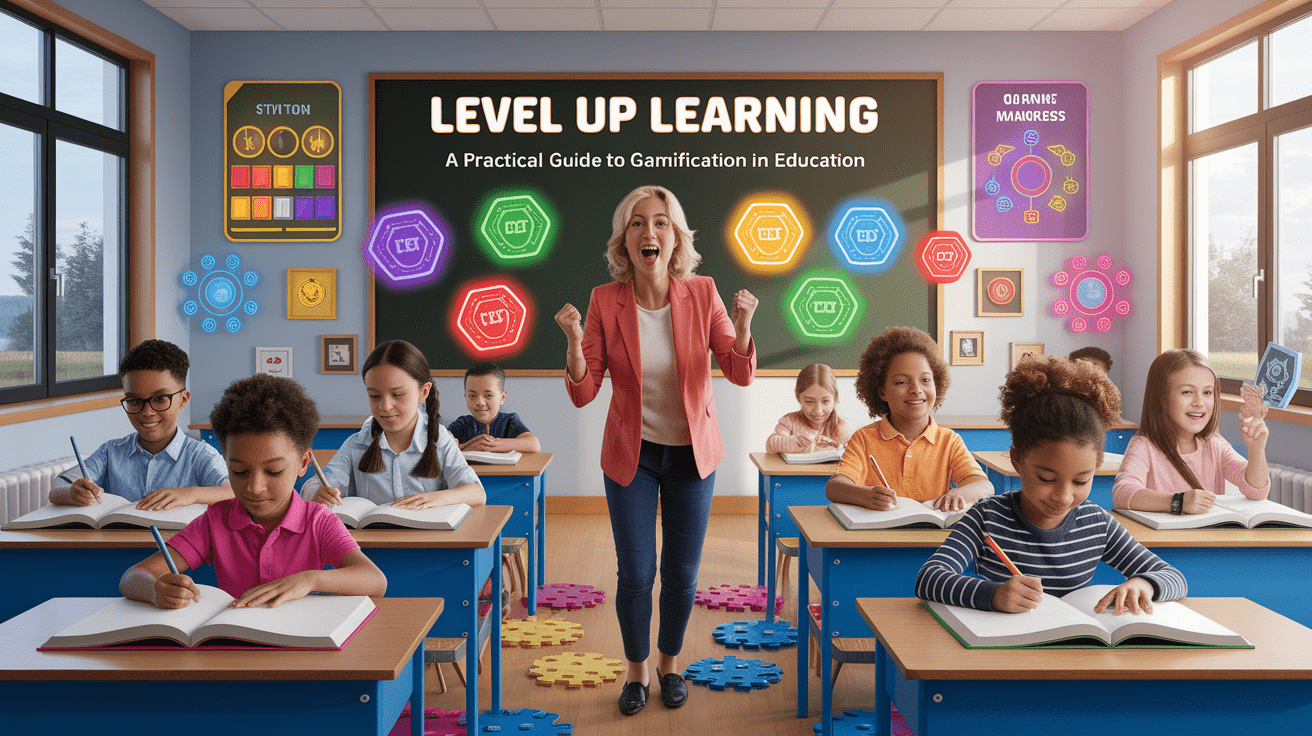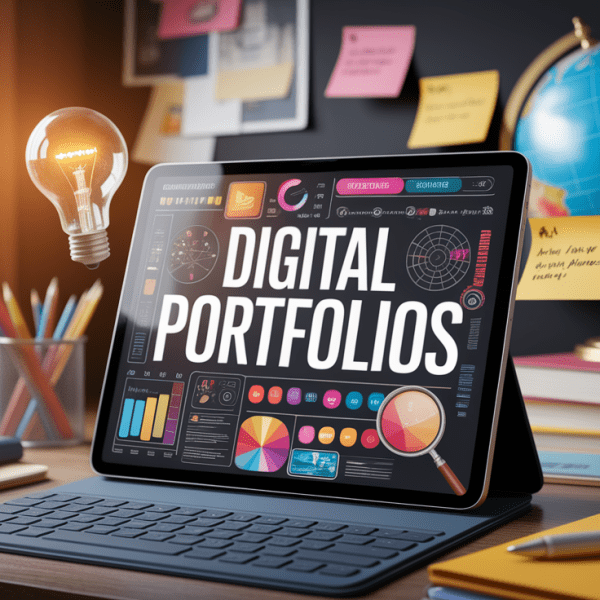Playing to Learn – Introduction
Picture this: it’s the middle of the afternoon, and you can feel the energy in the classroom beginning to wane. You’re explaining a key concept, but you’re competing with daydreams, yawns, and the ticking clock. We’ve all been there! As teachers, our greatest challenge is often finding new ways to spark curiosity and keep students invested in their own learning journey. What if you could transform that afternoon slump into an epic quest for knowledge? Enter gamification in education.
So, what is gamification in education? It’s not just about playing games in the classroom. Instead, it’s the art of taking game-like elements—think points, badges, leaderboards, and progress bars—and applying them to your educational content. It’s a powerful approach that taps into our natural human desire for achievement, competition, and fun. By framing learning as a game, you create an environment where students are motivated to tackle challenges, persist through failure, and celebrate their progress.
Gamification is one of the most exciting effective instructional strategies in a modern teacher’s toolkit because it directly addresses student engagement. Of course, lesson planning is essential for any successful teaching, and gamification provides a dynamic framework to build your lessons upon.
Key Benefits of Gamification
Bringing game mechanics into your classroom isn’t just about adding a layer of fun; it’s about transforming the learning environment. The benefits are wide-ranging, impacting everything from student motivation to your own planning process.

Boosted Engagement and Motivation
Let’s be honest, traditional worksheets can’t always compete with the interactive world our students live in. Gamification presents material in a familiar, exciting format that encourages them to lean in and participate. When a math problem becomes a “quest” and a correct answer helps them “level up,” the drive to succeed grows exponentially. This approach boosts engagement and motivation by creating a clear path to achievement.
The fear of failure can be paralyzing for students. In a gamified system, “failing” a level isn’t an endpoint; it’s an opportunity to try again with new insight. This low-stakes environment encourages persistence. The sense of achievement that comes from earning rewards and seeing visible progress is a powerful driver for student motivation, encouraging them to stick with challenging material.

Improved Learning Outcomes
When students are engaged, they learn more effectively. It’s that simple. High-quality educational games and gamified systems grab and hold students’ attention, leading to significant improvements in student achievement. For example, gamified math tools like ExploreLearning’s Frax have been shown to produce substantial math achievement gains. The combination of personalization, frequent rewards, and interactivity makes learning complex subjects more enjoyable and effective.
Furthermore, gamification can help students see the real-world applications of what they’re learning. A history lesson framed as a detective mission or a science unit designed as a journey to a new planet provides context and makes knowledge feel practical and relevant.
Cognitive and Physical Development
Beyond engagement, gamification has a direct impact on how the brain works. The challenge-and-reward cycle helps improve the brain’s ability to process and retain information. This active form of learning solidifies neural pathways more effectively than passive listening. Additionally, some forms of gamification can even encourage physical development. Think of a classroom scavenger hunt that requires students to move around the room to find clues or an interactive quiz on a smartboard that gets them on their feet.
Time-Saving for Educators
Here’s some great news for you, the teacher! Implementing gamification doesn’t have to mean more work. In fact, it can be a huge time-saver. Many gamified learning platforms come with pre-designed activities and automated tracking, streamlining your lesson planning process. Instead of creating materials from scratch, you can adapt existing `educational technology tools` to fit your curriculum. This frees you up to focus on what you do best: teaching and connecting with your students.
Implementing Gamification in Your Classroom
Ready to press start? The idea of “lesson gamification” might sound daunting, but you can begin with small, simple steps. Here’s a practical guide on how to implement gamification in the classroom.

- Start with Clear Learning Goals: Before you think about points or levels, define what you want your students to learn. A fun game without a purpose is just a distraction. The first step is always creating powerful lesson plan goals and objectives. What skill should students master by the end of this “quest”? What knowledge will they “unlock”?
- Choose Your Game Elements: You don’t need all of them at once! Pick one or two elements to start with.
- Points: Award points for completing assignments, participating in class, or helping a peer.
- Badges: Create digital or physical badges for mastering a skill (e.g., “Multiplication Master,” “History Detective”).
- Leaderboards: Foster friendly competition with a classroom leaderboard. To keep it positive, consider ranking teams instead of individuals or tracking “personal bests.”
- Levels: Structure a unit so that students “level up” after mastering each concept.
- Integrate into Your Lesson Plans: Gamification should enhance your teaching, not replace it. Think about how these elements fit into your existing structure. For guidance on structuring your gamified activities, reviewing the fundamentals of writing effective lesson plans can be a great help. For example, you could turn a chapter review into a quiz game or a research project into an “information scavenger hunt.”
- Select the Right Tools: There are amazing gamified learning platforms out there for every subject and grade level, like Kahoot!, Classcraft, Quizizz, and Blooket. These digital tools often come with ready-made content and make tracking points and leaderboards a breeze. But you don’t need technology to start! Sticker charts, classroom “money,” and hand-drawn badges can be just as effective.
- Connect Progress to Assessment: Game elements provide a fantastic opportunity for ongoing, informal assessment. You can see at a glance which students are excelling and who might need extra support. This approach aligns perfectly with the principles of integrating engaging assessment methods that go beyond the traditional worksheet or test.
Overcoming Common Challenges
Like any new strategy, gamification can come with a few challenges. But don’t worry, these “boss levels” are totally beatable with the right approach!

- The Challenge of Over-Competition: The use of badges and leaderboards can sometimes lead to unhealthy competition.
How to Beat It: Emphasize collaboration. Create team-based challenges where students work together to earn points. Celebrate personal growth and effort just as much as winning. Frame the leaderboard as a “class progress tracker” rather than an individual ranking. - The “I’m Not a Gamer” Student: Not every student is motivated by video game themes.
How to Beat It: Remember, gamification is about the mechanics, not just the theme. Focus on the universal appeal of progress, achievement, and recognition. Offer choices in how students demonstrate mastery—let them write an essay *or* create a presentation to “complete the quest.” - The Resource Drain: Thinking about building a complex gamified system from scratch can feel overwhelming.
How to Beat It: Start small! Gamify a single lesson or a weekly review. Use existing platforms that do the heavy lifting for you. You don’t need to turn your entire year into a game overnight. Incremental changes can have a huge impact.
Game Over? More Like Game On! – Conclusion
Gamification in education is more than a passing trend; it’s a dynamic and effective pedagogical approach that meets students where they are. By incorporating elements of play, you can ignite student motivation, deepen engagement, and improve learning outcomes in a way that feels both fun and meaningful. It changes the classroom narrative from “What do I have to do?” to “What can I achieve next?”
The beauty of classroom gamification is its flexibility. You can go all-in with a year-long quest or simply start by awarding badges for mastering a new skill. The key is to begin. So, take a look at your upcoming lessons and ask yourself: Where can I add a little more play? It’s time to level up your teaching and watch your students soar.




